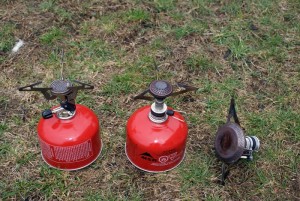
Canister Microstoves Review
There aren’t many outdoor product companies that have a full Wikipedia page devoted to an outdated, defunct product. But, both Primus and Coleman have that honor. As the developers of the first pressurized portable kerosene stove back in 1892, Primus reached the stage of being generic; people referred to having “Primus stoves“, regardless of the actual brand of the stove they owned. Coleman started a little later, creating the G.I. Pocket Stove for the U.S Military in World War II. Its significant improvement was that it didn’t require preheating from a separate source; the fuel in the pressurized canister was released into the burner for that purpose, making it easier to use in field conditions.
In recent years, though, Primus has flown a bit under the radar for many outdoors enthusiasts; ownership changes and product line changes caused it to disappear from many of the “big name” stores. But, they’re back , with some very high-tech products…and a little canister microstove called the “Express“($54 w/piezo ignition). Coleman, on the other hand, has continued to produce nearly legendary multi-fuel stoves that are remarkably similar to the original (albeit substantially smaller and lighter!). Coleman stoves are still the unit of choice for many summer camps, backpacking groups, etc., as they’re pretty much bulletproof, reasonably priced, and use cheap fuel. Along the way, Coleman created the canister microstove category with the F1 Ultralight($49.99, no ignition), a tiny blowtorch with the reliability expected of Coleman stoves.
We’ve been thoroughly impressed with the canister stoves that we’ve tested over the past couple of years, all solid, functional products. Still, the variation in product design offers a lot of choices for a consumer. These are far from commodity items. As we opened the box, we wondered…how would the Express distinguish itself from the crowd? And how would the long-in-the-tooth F1 stand up to the most modern products?
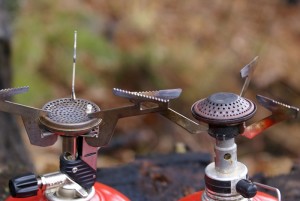
Even at first look, the Primus was different. For starters, the burner is a slightly concave bowl, rather than a convex (mounded) style like the F1. After some head scratching, we realized that it allows for the same surface area, but more spread out (theoretically, with more even heating on our pans). In addition, since canister fuel rises, it will automatically spread from the lower center to the higher edges, again meaning more even heating. Interesting. Of course, theory is one thing and practice is another. The Coleman’s burner shape is industry standard domed, a proven design.
A second design choice for Primus was to use solid, rather than folding, pot supports. While they fold into a flat package on one side of the stove, this DOES mean that the stove doesn’t fold down as small as either the Brunton Raptor or the Snow Peak GS-100A. Since one of our favorite uses for this type of stove is tucked into our GSI Pinnacle Dualist, that was a concern. Luckily, although it takes some finagling, we were able to make it fit. For the utter minimalist who tries to make overnights in a 2000 cubic inch daypack, the form factor will be an issue. For almost anyone else, it’s nothing to worry about.
The F1 folds flat just like the Primus, but can also be disassembled into two pieces, allowing it to tuck into a tiny corner of your pack. It’s as small as anything out there.
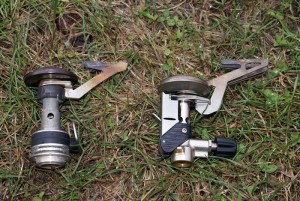
Speaking of minimalists, weight is always an immediate question. The Primus isn’t the lightest or the heaviest micro on the market. At 3.5 ounces, it’s right in the middle of all of the stoves we’ve tested. Of course, we’re talking minor differences among all of them, less than an ounce; we’re not QUITE crazy enough to make our choices based on that alone. The F1, at 3.1 ounces is still one of the lightest available. However, it doesn’t have a piezo ignitor, part of the reason that it’s as small and light as it is.
Getting the rest of the numbers out of the way with…how did the stoves perform in our standard burn test? As always, we tested them at 70F, with 1 liter of 70F water, indoors so there was no wind, and on a fresh MSR canister to get an accurate comparison. We used the pot from the GSI Dualist as a relatively common shape and size that would be used with stoves of this sort.
The Coleman posted a surprisingly strong time, reaching rolling boil in 4:11. Clearly, even though an older design, it’s still a powerhouse! The Primus, though, set a new record for us for microstoves at 3:47. That’s almost getting into the range of the ultra high-tech canister stoves; impressive for an ultralight. As an aside, Coleman for a while made a stove called the F1 Powerboost; an absolute monster of a “microstove” at 5.1 ounces and with a burner nearly 3″ across, it boiled a liter in 3:18. It would have been even faster, but the flame is so large that much of it was lost up the sides of the pot. If you need a canister stove for cooking big pots of pasta for large groups in the backwoods, you may want to look for one of these. At last check, a couple of retailers still had them available.
Empirical numbers, though, don’t tell the whole story. Real-world use isn’t just about how fast you can make the morning cup of coffee (hard as that may be to believe!). Stability is a big factor with any of these stoves, and these two came through with flying colors. The pot supports on the Coleman are rock-solid on the base, and large enough that pots aren’t excessively tippy (obviously, the larger the diameter of the pot, the more this becomes an issue). The supports weren’t slippery, either; the pots sat still, even without ridged bottoms. However, the shape of the supports (relatively flat) caused pots that had developed some warping on the bottom to be VERY unstable. The Primus, on the other hand, has much larger supports, but there’s more “wiggle” in them and the base; pots definitely feel more wobbly than with the F1. But, as the pots and frying pans got larger, the Primus started to overtake the Coleman, and with our most beat-up cookware, it was dramatically safer. A small, flat bottomed pot like the Dualist was great on the F1, but going beyond that wouldn’t be something we’d recommend.
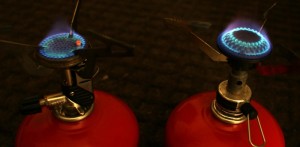
And then there’s the cooking factor. The Coleman claims to have a slow simmer. That may be true, depending on your personal definition. By ours, no. It turns down substantially, but isn’t in the league of something like the Brunton Raptor, for instance. If you value slow, even cooking, particularly with a 10″ frypan, the F1 wouldn’t be your choice. The Primus…now, THAT’S a simmer. We were amazed by just how low we could get the flame without it starting to flicker out; and, the burner design seemed to make it less susceptible to being blown out by light winds. The “hand test” (holding a hand over each at the same height above the burners) confirmed our opinion. We could keep our hands over the Primus for roughly twice as long as the Coleman without becoming uncomfortable. Beyond the low simmer factor, the design choice that Primus made in having a flat, concave burner means that the distance from the flame to the pan is greater without significantly increasing the total stove size; that allows the heat to spread more and heat the pan more evenly on low or high heat. Better for the pan, better for the food, better for the cook, who doesn’t have to stir QUITE as often.
Ultimately, the decision to choose a stove depends on your particular needs. If minimum size & weight are your triggers, the F1 is still a solid choice and excellent value (street price is often highly discounted from retail), as long as you don’t use large diameter pots. We simply can’t recommend it for that use. If, however, you value the flexibility of having fast boil times AND superb simmer control, the Primus Express is simply the best all-round canister microstove we’ve tested yet. The tradeoff of slightly more weight and bulk to have the performance, stability, and piezo ignition is, for us hedonists at least, a no-brainer.


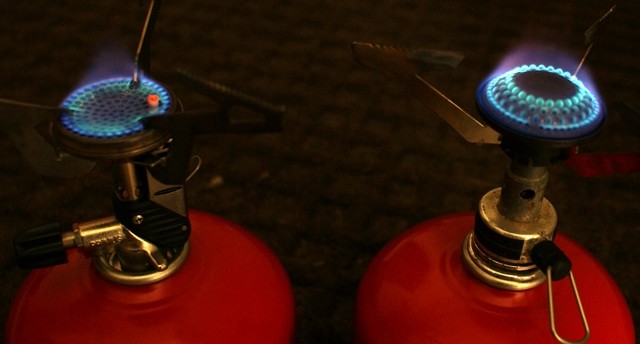
I just used my 20 year-old plus primus to make coffee this week when our electricity went out. Still works well!